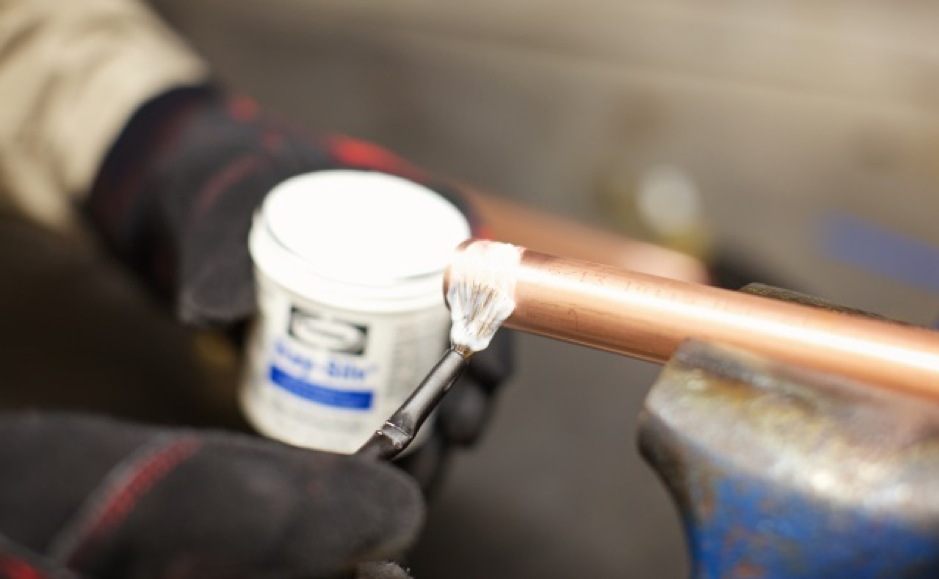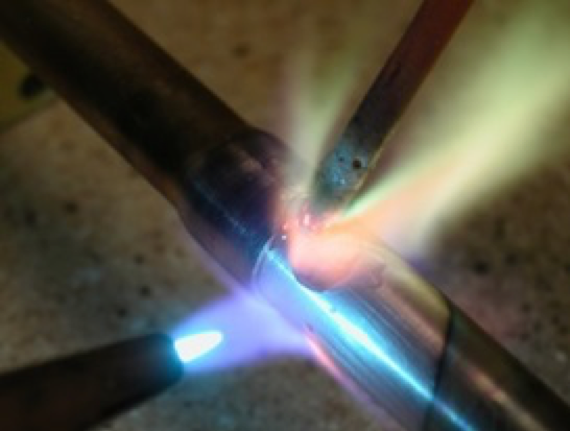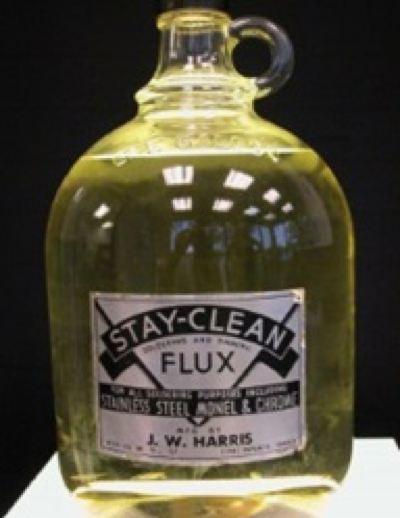
Bob Henson
At The Harris Products Group, we sell a lot of brazing and soldering alloys. Over the years we’ve noticed some misunderstandings about the importance of flux in producing a quality brazed joint. Here are the five most common misconceptions about flux.
Misconception #1: A flux is a cleaner.
It’s not actually. You must clean the parts to be brazed prior to applying the flux. Dirt, debris, oil and grease should be removed as the first step in any brazing or soldering process. Oxides can also be removed using a wire brush or a steel wool pad. Once the parts are clean, inside and out, then it’s time to apply your flux.
The flux is actually designed to absorb oxides that are generated while you are heating the parts in the brazing process. When you utilize an oxy-fuel based brazing set-up – such as oxy-acetylene, alternate fuel and even air-fuel – you will produce oxides during the heating process. Flux absorbs these oxides and prevents them from degrading the quality of the brazed joint.

Misconception #2: I can use the same flux for every job.
Your flux needs to be active at the same temperature as your consumable alloy. Fluxes are a mixture of chemicals, including fluorides and fluoroborates. The proportions and additional chemicals determine the active temperature range for a flux. Using a flux with the right temperature range ensures that the flux can be displaced by the molten alloy.
Harris alloys have recommended alloy selections, and a complete guide is included in the Guide to Brazing and Soldering on our website. Remember that copper to copper brazing does not require a flux.
Here are a few common combinations:
- Using Stay-Brite® Solder – Stay-Clean® Soldering Fluxes
- Using Bridgit® Solder – Bridget® Water Soluble Paste Flux
- Brazing copper to brass with Stay-Silv®, Harris 0, Blockade® or Dynaflow® – Stay-Silv® White Brazing Flux
- Brazing to steel with Safety-Silv® – Stay-Silv® White Brazing Flux
- Brazing to stainless steel with Safety-Silv® Brazing Alloys – Stay-Silv® Black Flux
- Induction brazing – Stay-Silv® Black Flux
- Aluminum brazing with Al-Solder® – Stay-Clean® Aluminum Soldering Flux
- Aluminum brazing with Al-Braze® – Albraze® EC Flux
Because the active temperature for the flux is the same as the active temperature for the alloy, you can actually tell when your torch temperature is ideal for brazing based on how the flux is behaving. When it begins to go transparent, you know you are up to temperature. If it doesn’t go clear, you know you need more heat.
Misconception #3: Cleaning the flux off is a pain.
Cleaning off the flux residue is an important step in the brazing process. When flux is used properly, it can be removed with a rag or brush and some water. If you don’t clean the parts, flux can become corrosive over time. It may also affect the performance of the part over time.
However, if you overheat during the brazing process, flux can char or burn on the part. To remove this, you may need a wire brush or even grinding or other mechanical means. Many brazing applications in a manufacturing environment will benefit from a consistent flame height and temperature. This will prevent overheating of the part and overheating of the flux.
Misconception #4: I can get my flux to last longer by diluting it with water.
Fluxes lose their effectiveness when diluted with water. Diluting flux can result in a significant impact to the quality of your braze, including:
- Burning or charring of the metals. If there aren’t enough chemicals in the applied flux, it won’t be able to absorb any more oxides. Those oxides then burn and char, affecting the metal. To remove this burning and charring, you may need additional steps to clean the flux – including grinding or other mechanical means. This is often more costly than simply using the flux at its intended strength.
- Preventing the alloy from flowing into the joint or space. Without the presence of flux, because it is seriously diluted or unevenly mixed with water, the consumable alloy won’t ball-up as it should and flow into the joint. The integrity of the joint is compromised by the lack of flux. Even if you get it to braze, you’ll likely have to rework or re-braze the joint.

Misconception #5: It doesn’t matter who I buy my flux from.
When choosing a consumable alloy, the quality and consistency is important to you. It is equally important when selecting a flux. Ensuring that your materials perform the same way every time allows you to produce a high-quality end product every time. The Harris Products Group applies strict quality standards for all of its products, including fluxes.
All Harris fluxes meet AWS A5.31 standards based on the appropriate classification. In addition to standalone fluxes, Harris also sells a variety of flux-cored alloys, providing an all-in-one solution. These products include Safety-Silv® 45FC, Cor-Al and others.
Harris has a long history with fluxes, beginning in 1937 when Joe Harris developed Stay-Clean, a liquid soldering flux. It was so well-received in the market place that Harris changed his business model from auto repair to selling flux. For nearly a century, The Harris Products Group has been on the forefront of delivering innovative and high-quality products. Our engineering team continues to develop products to meet the needs of professionals in manufacturing environments and in the field.
